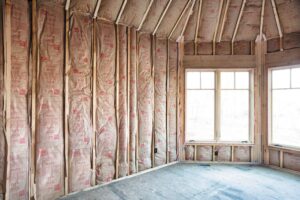Introduction
If you are a new homeowner or planning to renovate your home then, knowing the proper insulation is most important for you. Because a well-insulated home is important for your comfort.
So, can you use R13 insulation for your ceiling?
Yes, you can use R13 insulation in your ceiling. However, it is important to note that R13 insulation is not as effective at insulating your ceiling as other types of insulation, such as R19 or R21 insulation. If you live in a cold climate, you may want to consider using a higher R-value insulation in your ceiling.
Now, let’s see the details regarding R13 in the ceiling and the best uses of this R-value.
What Happens If You Use R13 Insulation In Ceiling?
Well, if you really want to use R13 insulation in your ceiling then you must be alert of some difficulties that you may have. So, let’s get into the discussion.
R13 batt insulation is mainly for interior wall cavities to reduce sound. It is a large blanket, designed specially to fill a wall or floor cavity. There is a difference between wall and ceiling insulation.
Though both of the products are made from the same materials different in thickness and density. While insulating your ceiling, you should maintain the proper R-value for insulation according to the manufacturer’s instructions.
The proper R-value is based on thickness, material, age, density and moisture absorption. The higher the R-value, the better it will resist heat transfer.
 Source: Amazon
Source: Amazon
Heat Resistance
You should consider the climate of your area when planning your ceiling insulation. If you live in extremely hot weather, you won’t need insulation with higher R-values. In that case, you can use R13 insulation for your ceiling.
But fibreglass batt insulation is better for cold temperatures and R13 batt hits on the temperature of 60°F.
On the other hand, while considering R-value you can not insulate R-value 13 if your location is in the Northeast. You may then need insulation between R25 and R30.
The thickness of The Insulation
So, when you come for ceiling insulation you need thicker fibreglass batt insulation. Because ceiling insulation generally requires more thickness. Wall insulation is not thick enough for the ceiling.
Here, we gave a chart of the most common R-value for ceilings highlighting their thickness.
| R-value | Fibreglass thickness (inches) | Cellulose thickness
(inches) |
| R 30 | 10.25” | 9.3” |
| R 38 | 12.75” | 11.6” |
| R 49 | 16.25” | 15” |
R13 fibreglass batt insulation is typically 3.62 inches thick, especially for wall or floor cavities. But you need 9-16 inches of fibreglass or cellulose insulation for ceiling installation.
And do you have limited space in your ceiling? Flat roofs and cathedral ceilings often have limited cavity depths.
In that case, you can use wall insulation in the ceiling but the manufacturer recommends high-density wall insulation such as – R2.7 HD, R3.1 and R4.0 HD acoustic batts.
So, based on the thickness and heat resistance of R13, this will not be your proper insulation for the ceiling. You may face trouble after using R13 in ceiling.
Alternative Insulation for Ceiling
Instead of R13, you can use R30, R38 and R49 insulation for your ceiling. Basically, these R-values are recommended for ceiling and attic space insulation. R13 to R23 are for external wall insulation.
| R-value with size | Average Price |
| R30 15 in. x 25 ft. | $36 |
| R38 24 in. x 48 in. | $139 |
| R49 14 in. x 16 in. x 48 in. | $ 316 |
 Source: Service Experts
Source: Service Experts
Can You Use R13 Insulation for The Basement Ceiling?
Yes, you can insulate R13 for your basement ceiling. When sound travels through the air, R13 of any material works well. Because it is the place where you store everything: machines, instruments and many more.
As your basement is underground, the ground provides some natural protection. You have to ensure that your moisture layer is in good condition and free of holes or other damage.
For your basement ceiling insulation, you will need a minimum R-value of 10. The insulating surface will be more heat-resistant the higher the number.
As you will not insulate the basement ceiling for heat resistance, choosing R13 will be your best decision.
Before insulation in your basement, you should consult with a building professional again. If you are living in a cold climate, you can think about insulation with an R-value of 13 to 25.
How to Install R13 for The Basement Ceiling?
Installing R13 in a basement ceiling can be a DIY project. But you have to take important safety precautions and follow proper installation techniques. Here are the steps for the installation of R13 in your basement ceiling.
Step 1: First, clean the ceiling to remove any dirt or debris.
Step 2: Measure the area of your ceiling and then purchase the appropriate amount of R13 insulation batt.
Step 3: Install a vapor barrier if you have a crawl space with a dirt floor. It will prevent moisture from penetrating the insulation. You can also use plastic sheeting to create a barrier.
Step 4: Now, put on the protective clothing, gloves, mask, and eye protection. Then, start to insert the insulation, starting at one end of the ceiling, between the joist with the paper side facing down.
Step 5: The insulation should fit properly without any gaps. You can add one more layer of insulation for soundproofing which will create an effective barrier.
Step 6: Once the insulation is inserted, staple the paper facing of each batt carefully to the sides of the joist to secure it in place.
 Source: Aireserv
Source: Aireserv
Step 7: Seal any air leaks or gaps around the perimeter of the ceiling with foam insulation to prevent air infiltration.
So, this is the full process of basement ceiling insulation with R13. For a better understanding, you can watch this video.
How to install Ceiling Insulation in a Basement or Crawlspace & why you should. R30, R21, R19, R13.
FAQs
What Is The Safest Insulation?
The safest insulation is cellulose. It is not harmful or flammable. Cellulose has a high R-value and is also easy to install. Its main attraction is the material. Cellulose insulation is an eco-friendly and sustainable option because it is made from recycled material.
What Is The Cheapest Home Insulation?
Batt or roll insulations are the cheapest types of home insulation. It is also the easiest insulation and is especially used for DIYers. Fibreglass batt is made from glass fibres and is commonly used in attics, walls and floors.
What Insulation Is Best For Audio?
One of the most effective types of insulation for soundproofing is mineral wool and molten rock. This type of insulation has high density and is excellent at observing sound waves. You will have another option for soundproofing insulation is blown-in cellulose insulation.
Conclusion
Thank you for being patient till the end of the conversation. I tried to answer your question about using R13 insulation in ceiling. Hope this article will help you. You can use R13 insulation for your ceiling depending on the above issues.
That’s all for today. Good luck!



